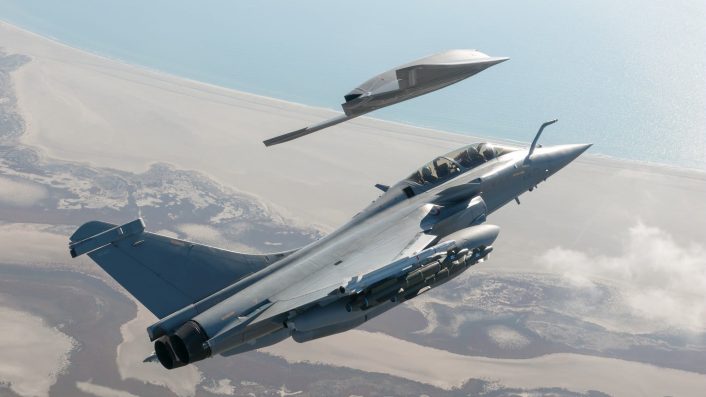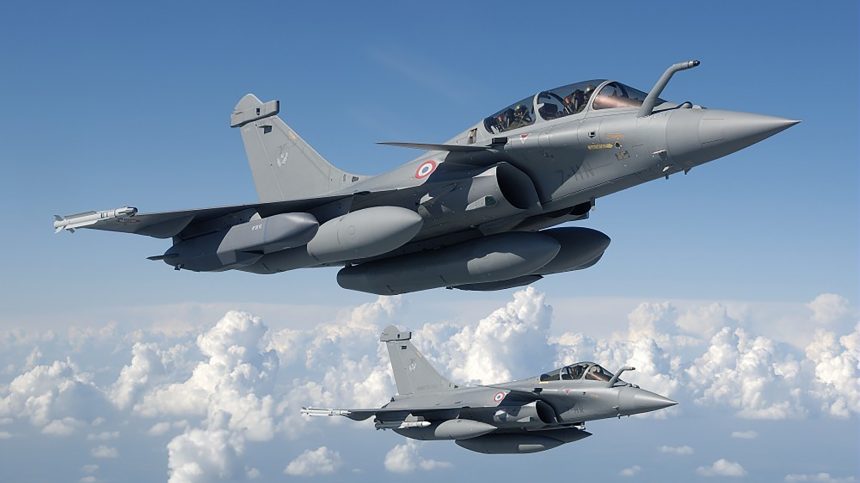The Dassault Rafale is a multirole 4th generation (or 4.5+ in the latest version) fighter jet capable of supersonic flight, developed and manufactured by the French aerospace company Dassault Aviation. This delta-wing, twin-engine aircraft features a canard design and represents one of the most advanced combat platforms in service today.
The Rafale fighter jet, whose name can be translated either as “gust of wind” or “burst of fire” (similar to the Italian Raffica, the nickname of the Caproni Ca.331) originated from a joint request from the French Air and Space Force (Armée de l’Air) and French Navy (Marine Nationale) in the late 1970s to replace their then-current line-up, mainly made up of Vought F-8 Crusaders, Dassault Etendards and Dassault Super Etendards in the Navy and by different versions of the Dassault Mirage and SEPECAT Jaguars in the Air Force.
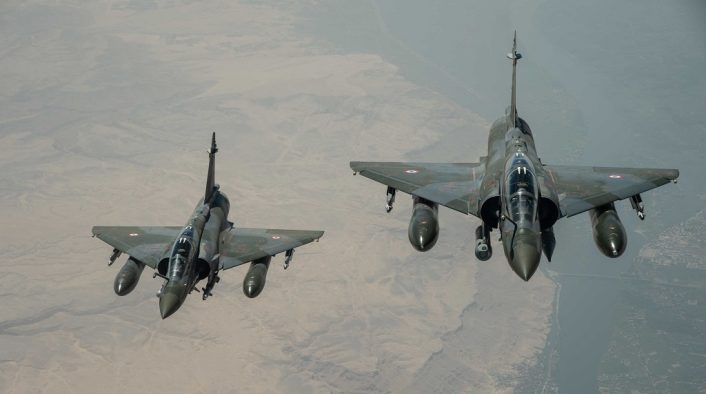
About the Dassault Rafale
In 1979, Dassault-Breguet joined forces with MBB (Messerschmitt-Bolkow-Blohm, later merged into EADS that then became Airbus) and BAe (British Aerospace). These two firms had recently developed together with Aeritalia the Pan-European Panavia Tornado aircraft. This partnership aimed to create a new multirole fighter under the “European Combat Aircraft” (ECA) program, which would eventually influence the development path of the Dassault Rafale, a 4.5-generation jet built for air superiority, ground support, and reconnaissance.
The ECA program, however, collapsed in 1981 due to conflicting national requirements, but was soon replaced in 1983 by the “Future European Fighter Aircraft” (FEFA or EFA) program in 1983, a short-lived multinational initiative that ultimately gave rise to the Eurofighter Typhoon, a contemporary of the Rafale fighter jets in the modern combat aircraft landscape.
Once again, differing requirements, with the French preferring a lightweight, multirole land- and naval-based aircraft and the British instead favouring a land-based heavy long-range interceptor plane, put too much of a strain on the project, with France retiring in 1985. The other partners, the United Kingdom, Germany and Italy, moved forward to make the Eurofighter Typhoon, a rival to the French-developed Rafale plane.
Two fighter generations (and 40 years) later, a similar divide would again emerge over the development of the future 6th generation fighter, with France, Germany, and Spain teaming on the Future Combat Air System, while the United Kingdom, Italy, and Japan preferring the Global Combat Air Programme Tempest.
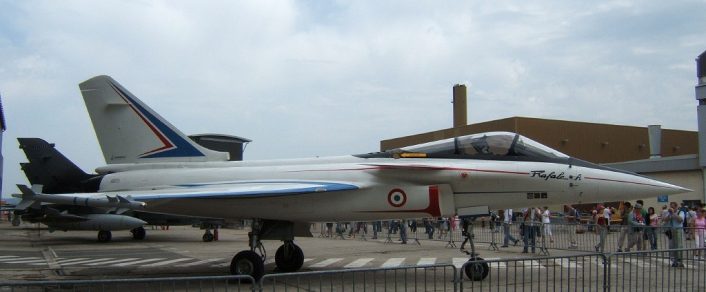
While the international saga was panning out, Dassault had been working on the ACX (Avion de Combat Experimental, meaning Experimental Combat Aircraft) project, initially codenamed Rapace (French for Bird of Prey) since the late 1970s.
By early 1980, ACX was narrowed down to 4 configurations, with 2 of them sporting the canard configuration and delta wings that would end up on the Dassault Rafale. On April 13, 1983, it finally received the green light for building the first prototype, marking a major milestone in the Rafale jet origin story.
With new impetus after the French withdrawal from EFA, the now renamed Rafale would finally be unveiled on December 13, 1985, at Saint-Cloud in the presence of Marcel Dassault.
The founder of Dassault Aviation (and in an interesting quirk of history, classmate in 1913 of Mikhail Iosifovich Gurevich of MiG fame) Marcel Dassault, who was born as Marcel Ferdinand Bloch and only took the surname Dassault after World War II (and his imprisonment for refusing to cooperate with the occupier first by the Vichy regime and later by the nazis in the Buchenwald concentration camp) from the nome de guerre in the French Resistance of his brother, General Darius Paul Bloch, would therefore be able to see the presentation of its last plane, but would die at 94 years on April 17, 1986, only mere weeks away from the first flight of the Rafale prototype from Dassault’s facility at Istres, on July 4, 1986.
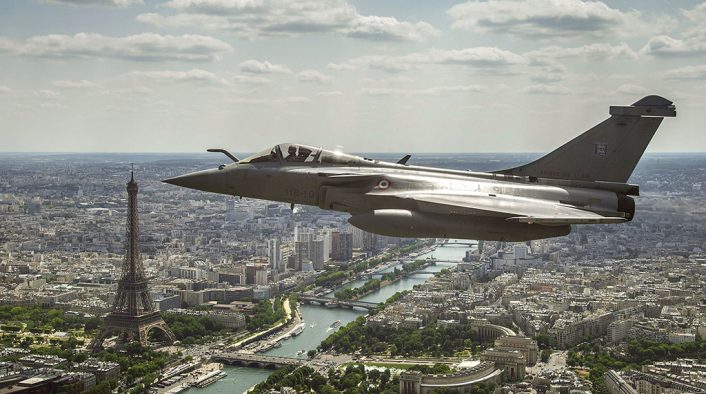
The Rafale A then underwent an intense testing program, first flying in 1990 with the updated French-made Snecma M88 engine. This twin-engine configuration became a defining trait of the Dassault Rafale fighter jet, supporting its multirole performance capabilities. The Rafale A was eventually retired in January 1994.
Meanwhile, in April 1988, a contract had been awarded for the initial production of Rafale variants for testing, but only after the Marine Nationale almost decided to select discounted and already available American F/A-18 Hornets in their place. However, the decision to support domestic aerospace ensured the continued development of the Dassault Rafale, which ultimately included dedicated naval variants like the Rafale M for carrier operations.
The “peace dividends” defence spending cuts after the end of the Cold War, and the increased costs of developing a national program (after the failure to include other European countries) threatened the Rafale, but French determination to achieve “strategic autonomy” in this delicate sector carried on the program, with further testing in the 1990s and finally entry into service in the early 2000s, marking a turning point in the history of the Rafale aircraft.
The Marine Nationale received its first Rafales in December 2000, with the first combat deployment occurring in 2002, even before the embarked Rafale M was declared fully operational in June 2004.
The Armee de l’Air followed suit, receiving the first Rafales in 2005 and achieving full operational status from mid-2007.
On March 12, 2007, the French Air and Space Force deployed Rafale fighter jets abroad for the first time. Their operational debut followed on March 28, 2007, when a Dassault Rafale aircraft dropped a GBU-12 laser-guided bomb in support of Dutch forces in southern Afghanistan. This marked the beginning of the Rafale’s combat use in international operations.
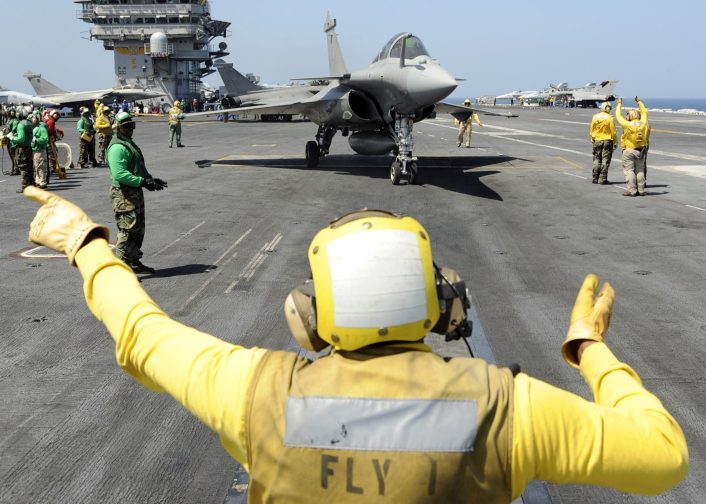
The Rafale, despite being very innovative thanks to its advanced fly-by-wire control, extensive use of composite materials, development using the proprietary CATIA tool for computer-assisted design (being the first plane built digitally without a physical model) and an extremely advanced SPECTRA electronic warfare system, coupled with the use of IR-guided long-range Air-to-Air missiles (a tactic shared only with the Soviet/Russian fighters) that make it a powerful threat even to 5th generation fighters, initially found few foreign buyers.
This rapidly changed with the major role that Rafales played in the NATO-led intervention in Libya in 2011 when Rafales, usually armed with four MICA air-to-air missiles and four or six AASM “Hammer” guided bombs, plus a Thales Damoclès targeting pod and two drop tanks, conducted numerous strike with the distinction of being able to operate without SEAD and Electronic Warfare assets, thanks to their SPECTRA EW Suite.
From then on, sales of the Rafale soared while the plane took part in the air war against ISIS/Daesh in the Middle East and operations against al Qaeda in Africa. The Rafale plane proved to be a reliable platform for sustained expeditionary operations.
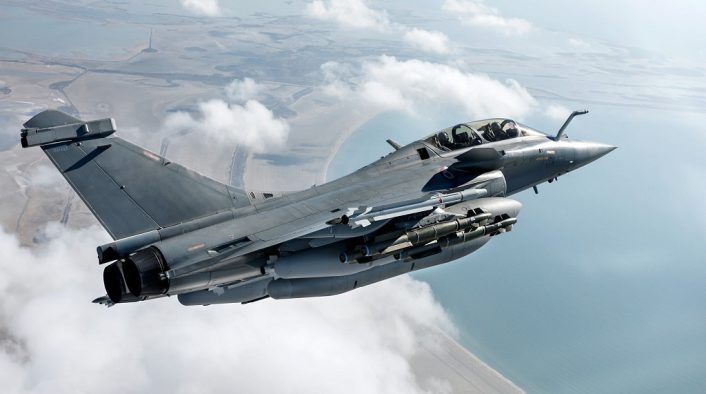
In January 2013, Rafale fighter jets were deployed as part of Opération Serval in Mali. Since September 2014, they have operated over Syria and Iraq for Opération Chammal, including the joint Franco-British-American strike of April 14, 2018, against Syrian chemical warfare targets, with each Rafale loaded with a couple of SCALP EG air-launched cruise missiles for the task (with 5 Rafales present launching nine cruise missiles).
Recently, the French Air Force’s Rafales based in Jordan helped defend Israel from the Iranian attack on April 13, 2024, by shooting down an unspecified number of unmanned aerial vehicles.
The intense use of the Rafale finally earned it its first foreign customer on February 16, 2015, when Egypt became the Rafale’s first international customer, buying 24 jets as part of a €5.2 billion ($5.9 billion) deal also including a FREMM frigate and weapons.
As of August 2024, the Rafale, which is manufactured in a 24-month-long process almost entirely in France and with French components to be free of foreign influence and export vetoes, has gathered a grand total of 507 orders from 9 countries, with 289 airframes already produced and 223 backlog planes.
The 507 orders are for 302 single-seat Rafales, 157 twin-seaters, and 48 naval single-seaters.
Initially planning to order 250 Rafales for the Air Force and 86 for the Navy, France scaled back the purchase to 286 planned airframes, of which 234 have been ordered.
By 2024, 166 Rafales had been delivered to the French Armed Forces, with 12 airframes in service then being sold to Greece and a further 12 to Croatia, leaving France with around 143 Rafales, around 100 in the Air Force and 41 in the Navy.
In the end, France plans to operate 225 Rafales, 185 in the Armee de l’Air and 40 for the Marine Nationale.
Seven Rafales have crashed as of 2024 (all in French service), with the latest incident being an in-flight collision between two Rafales on August 14, 2024.

Dassault Rafale: Variants
Rafale A
Technology demonstrator, first flight in 1986.
Rafale B
Two-seater production version for the French Air and Space Force, 157 airframes.
Initially expected to be used only as a trainer, but the experience gained in the Gulf War showed that a second crew member was helpful on strike and reconnaissance missions.
Rafale C
Single-seater production version of the Rafale B, 302 airframes.
Rafale M
Single-seater similar to Rafale C, but modified to operate from CATOBAR aircraft carriers with a stronger airframe, larger tailhook and a built-in ladder. 48 ordered, with production almost completed as of 2024 (unless further orders are placed, with India being a probable candidate).
Rafale N
Also known as Rafale BM, the proposed twin-seater version for the Marine Nationale. Never produced.
Rafale R
Proposed variant optimized for reconnaissance. Never produced.
Note: some export versions, despite being comparable to French versions, have a different nomenclature.
Rafale DM
Twin-seater version for the Egyptian Air Force, F3-R standard.
Rafale EM
Single-seater version for the Egyptian Air Force, F3-R standard.
Rafale DH
Twin-seater version for the Indian Air Force, F3-R standard.
Rafale EH
Single-seater version for the Indian Air Force, F3-R standard.
Rafale DQ
Twin-seater version for the Qatar Emiri Air Force.
Rafale EQ
Single-seater version for the Qatar Emiri Air Force.
Rafale DG
Twin-seater version for the Hellenic Air Force.
Rafale EG
Single-seater version for the Hellenic Air Force.
F1 Standard
Original 10 Rafale Ms with only air-to-air functions, deployed in an emergency from 2000 to the Navy to replace the aging F-8 Crusaders.
F2 standard
Rafales with updated air-to-air capabilities and the introduction of air-to-ground munitions.
In service since 2005, but all airframes are now updated to the F3 standard.
F3 standard
The update started in 2006 and entered service in 2009.
Rafale in the F3 configuration have an updated RBE2 AESA radar, upgrades to the OSF optical sensor, upgraded SPECTRA, new M88-2 engines, the ability to carry the Damocles laser-targeting pod and is cleared to use the Air-Sol Moyenne Portée Amélioré (literally Modernized Air-to-Ground Medium-range munition, known as ASMP-A) 300kt nuclear supersonic missile.
F3-R standard
Starting from 2018, all French Rafales are to be upgraded to F3-R standard, adding the capability to use the TALIOS pod and the Meteor air-to-air missiles, in addition to the Automatic Ground Collision Avoidance System (AGCAS).
F4 Standard
Slated to be introduced operationally from 2023, with improvements to the software and data analysis of the plane, in addition to upgraded engines and upgraded RBE2 AESA radar, with better air-to-ground capabilities.
Rafale F4 also add the Thales Scorpion helmet and the ability to carry new MICA-NG Medium-range Air-to-Air missiles.
F4.1 Standard
Aircraft produced before September 2020 can be upgraded to Rafale 4.1 with software updates but with limited hardware evolution.
F4.2 Standard
Rafales produced after September 2020 can be upgraded to 4.2 standard with software and structural upgrades.
F5 Standard
Future upgrade expected by 2030, with the introduction of the hypersonic ASN4G (Air-Sol Nucléaire de 4ème Génération, 4th Generation Air-to-Ground Nuclear munition) missile and UCAV teaming.
Along with the proposed F6 Standard, future Rafales are expected to have further modernized SPECTRA, improved stealth features, the ability to carry newer missiles (like the new anti-ship/cruise missile) and integration with 5th and 6th generation fighters like F-35 and FCAS.
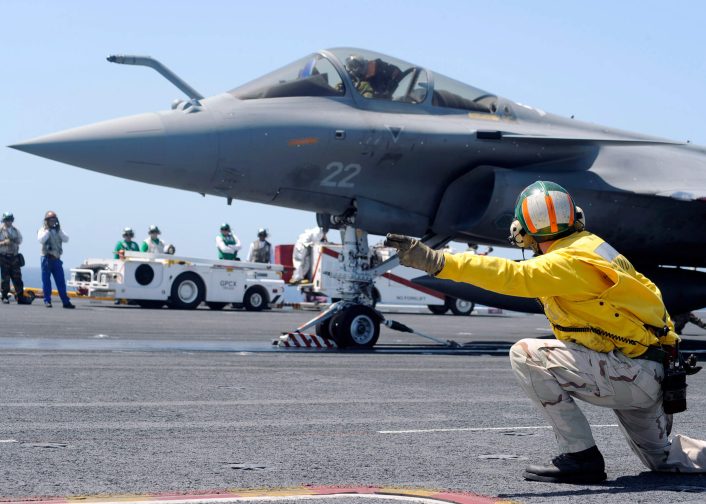
Dassault Rafale: Operators
As of 2024, 289 Rafales had been produced and are in service with 7 countries, with 2 other foreign customers slated to start receiving them in the coming years and further countries evaluating the plane in their competition to replace older fighters.
The French Air Force received 166 Rafales, but sold a total of 24 airframes to Greece and Croatia.
Expected to operate a total of 225 Rafales, 185 for the Air Force and 40 for the Navy.
In service with the French Air Force the around 100 airframes are operated by:
- Escadron de Chasse 2/4 La Fayette and Escadron de Chasse 1/4 Gascogne, both for nuclear strikes, and Escadron de Transformation Rafale 3/4 Aquitaine for Operational Conversion, from Robinson Air Base at Saint-Dizier.
- Escadron de Chasse 2/30 Normandie-Niemen and Escadron de Chasse 3/30 Lorraine for multirole use and Escadron de chasse et d’expérimentation 1/30 Côte d’Argent for tactics development and evaluation, from Mont-de-Marsan Air Base.
- Escadron de Chasse 1/5 Vendée for multirole operations, from the Orange-Caritat Air Base.
- Escadron de Chasse 1/7 Provence for multirole use, deployed at Al Dhafra Air Base, UAE.
In service with the French Navy, the 41 multirole carrier-based Rafales are operated by:
- Flottille 11F, Flotille 12F, and Flotille 17F based at Naval Air Base Landivisiau
Of the 55 Rafales sold to Egypt, the 24 delivered from 2015 to 2019 (16 two-seat and 8 single-seaters) are in service with the 34th and 36th tactical fighter squadrons of the 203rd Tactical Fighter Wing of the Egyptian Air Force, operating from Gebel el Basur airbase.
31 further Rafales sold in 2021 (12 two-seaters and 19 single-seaters).
The Qatar Emiri Air Force operates 36 Rafale (with Qatar having an option for a further 36 planes), flown by the 1st Fighter Squadron ‘Al Adiyat’ from Dukhan / Tamim Airbase.
The Indian Air Force operates 36 Rafale (28 single-seat and 8 dual-seat, while the Indian Navy is negotiating for 26 Rafale M naval planes, flown by the No. 101 Squadron (Falcons) from Hasimara AFS (Air Force Station) and the No. 17 Squadron (Golden Arrows) from Ambala AFS.
The Hellenic Air Force of Greece operates 20 out of the 24 ordered Rafales (with 12 ex-Armee de l’Air and 12 new airframes), flown by the 332nd All Weather Squadron (Hawks) from Tanagra Air Base.
The Croatian Air Force operates 6 of the 12 Rafale ordered (10 ex-French Rafale C F3-R and 2 twin-seater Rafale B F3-R), with the remaining airplanes to be delivered in 2025.
The Croatian Rafales are based at the 91st Air Force Base in Zagreb.
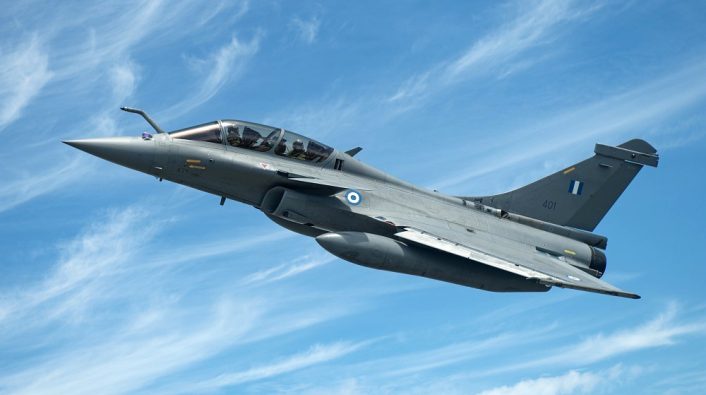
The Indonesian Air Force ordered 42 Rafale F4s, expected to be delivered from 2026 and to be operated by the 12th Air Squadron (Black Panther) and the 16th Air Squadron (Rydder) of the 6th Air Wing from Roesmin Nurjadin AFB, Pekanbaru, and by the 1st Air Squadron (Equatorial Eagles) of the 7th Air Wing from Supadio AFB, Pontianak.
The Serbian Air Force and Air Defence ordered 12 Rafale F3s in August 2024 (with a further 12 under negotiation), expected to be delivered by 2029.
The United Arab Emirates Air Force is expected to operate 80 Rafale F4s, ordered in 2021 and to be delivered from 2026
Furthermore, the Rafale is said to be undergoing consideration by Iraq, Saudi Arabia, Colombia, Perù, Uzbekistan and the Philippines.
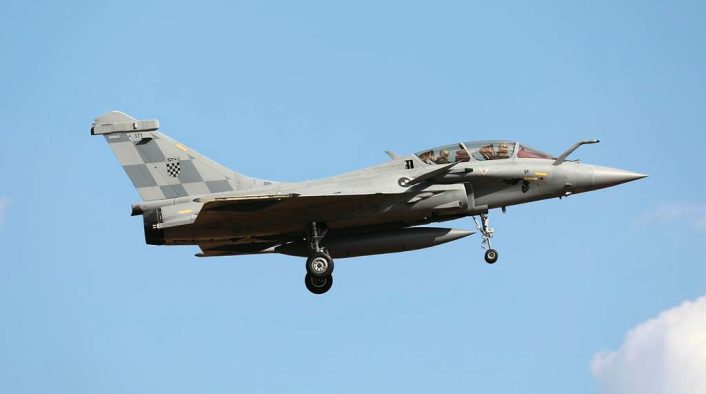
Dassault Rafale: Specifications
General Characteristics
- Crew: 1 (Rafale C and Rafale M) or 2 (Rafale B)
- Length: 15.27 m (50 ft 1 in)
- Wingspan: 10.90 m (35 ft 9 in)
- Height: 5.34 m (17 ft 6 in)
- Empty weight: 10,300 kg (22,708 lb) Rafale B, 9,850 kg (21,720 lb) Rafale C, 10,600 kg (23,400 lb) Rafale M
- Gross weight: 15,000 kg (33,069 lb)
- Max takeoff weight: 24,500 kg (54,013 lb)
- Fuel capacity: 4,700 kg (10,362 lb) internal for Rafale C; 4,400 kg (9,700 lb) for Rafale B
- Powerplant: 2 × Snecma M88-4e turbofans, 50.04 kN (11,250 lbf) thrust each dry, 75 kN (17,000 lbf) with afterburner
Performance
- Maximum speed: 1,912 km/h (1,188 mph or 1,032 kn) / Mach 1.8
- Supercruise: Mach 1.4 with 6 missiles
- Combat range: 1,850 km (1,150 mi or 1,000 nmi) on penetration strike mission with 3 tanks (5,700 L combined), two SCALP-EG cruise missiles, and two MICA AAMs
- Ferry range: 3,700 km (2,300 mi, 2,000 nmi) with 3 drop tanks
- Service ceiling: 15,835 m (51,952 ft)
Armament
The Rafale is armed with one 30 mm GIAT 30/M791 autocannon with 125 rounds, and can carry up to 9,500 kg (20,900 lb) external fuel and ordnance on its 14 hardpoints (for the Rafale B and C versions, while the naval Rafale M only has 13 hardpoints).
The Rafale can carry MICA EM and MICA IR (plus new MICA-NG) medium-range AAMs or the new Meteor long-range AAM, while the air-to-ground operations are accomplished with either unguided Mk82 iron bombs or guided GBU-12, GBU-16, GBU-22, GBU-24, and GBU-49 Paveway II bombs.
Rafales can also carry French AASM-Hammer guided bombs, AM 39 Exocet anti-ship missiles and Storm Shadow/SCALP-EG cruise missiles, along with the derivative Apache anti-runway missiles.
For the nuclear deterrence role, Rafales can also be equipped with the ASMP-A nuclear missile, which should be replaced in the future by the ASN4G hypersonic missile.
Beyond munitions, the hardpoints of the Rafale can also be used to carry the Thales Damocles targeting pod, the Thales AREOS (Airborne Recce Observation System) reconnaissance pod, or the Thales TALIOS multi-function targeting pod, in addition to up to 5 drop tanks and a buddy–buddy refueling pod.
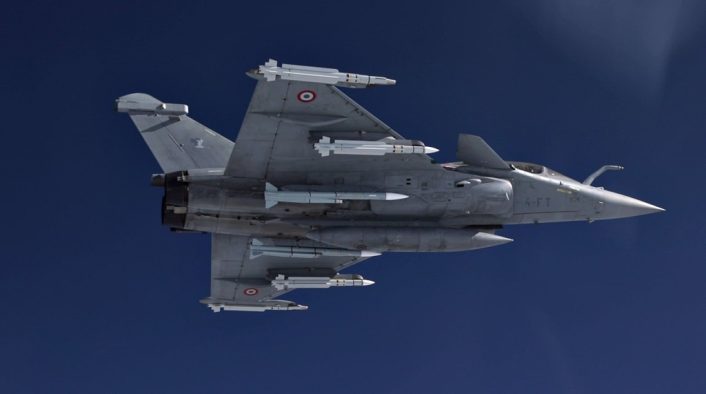
Dassault Rafale Milestones
- Avion de Combat Tactique (ACT) program: December 1977
- ACX program: Oct. 30, 1978
- ACX first contract: Apr. 13, 1983
- Rafale A presentation: December 1985
- Rafale A first flight: July 4, 1986
- Rafale A first landing on Clemenceau aircraft carrier: Apr. 30, 1987
- Rafale officially selected: Jan. 26, 1988
- Rafale A first flight with M88 engine: May 1990
- Rafale A retirement: January 1994
- Rafale C first flight: May 19, 1991
- Rafale B first flight: Apr. 30, 1993
- Rafale M first flight: Dec. 12, 1991
- Rafale M introduction: May 18, 2001
- Rafale M first deployed to a combat zone: 2002
- Rafale M operational: Jun. 25, 2004
- Rafale B F2 first delivered to the Air Force: April 2005
- Rafale B operational: Jun. 26, 2006
- Rafale B first combat mission: Mar. 12, 2007
- Rafale B first combat use of GBU-12: Mar. 28, 2007
- Rafale M F2 operational: May 21, 2008
- Rafale combat debut against Libya: Mar. 19, 2011
- Rafale combat debut against Daesh: September 2014
- Rafale joint bombing of Syrian chemical warfare targets: Apr. 14, 2018
- Rafale first operational with foreign customers: Feb. 16, 2015 (Egypt)
- Rafale combat targeting of drones: Apr. 13, 2024
- Rafale latest foreign sale: August 2024 (Serbia)
- Rafale M refuels an A400M during a test: November 2024
